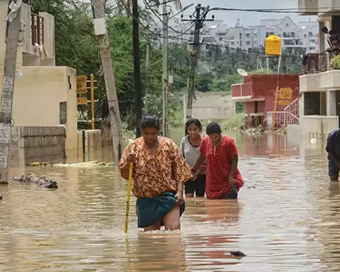Gallery
 PM Modi visit USA
PM Modi visit USA Only the mirror in my washroom and phone gallery see the crazy me : Sara Khan
Only the mirror in my washroom and phone gallery see the crazy me : Sara Khan Karnataka rain fury: Photos of flooded streets, uprooted trees
Karnataka rain fury: Photos of flooded streets, uprooted trees Cannes 2022: Deepika Padukone stuns at the French Riviera in Sabyasachi outfit
Cannes 2022: Deepika Padukone stuns at the French Riviera in Sabyasachi outfit Ranbir Kapoor And Alia Bhatt's Wedding Pics - Sealed With A Kiss
Ranbir Kapoor And Alia Bhatt's Wedding Pics - Sealed With A Kiss Oscars 2022: Every Academy Award Winner
Oscars 2022: Every Academy Award Winner Shane Warne (1969-2022): Australian cricket legend's life in pictures
Shane Warne (1969-2022): Australian cricket legend's life in pictures Photos: What Russia's invasion of Ukraine looks like on the ground
Photos: What Russia's invasion of Ukraine looks like on the ground Lata Mangeshkar (1929-2022): A pictorial tribute to the 'Nightingale of India'
Lata Mangeshkar (1929-2022): A pictorial tribute to the 'Nightingale of India' PM Modi unveils 216-feet tall Statue of Equality in Hyderabad (PHOTOS)
PM Modi unveils 216-feet tall Statue of Equality in Hyderabad (PHOTOS)The Badminton Association of India (BAI) has announced a 14-member-strong India squad for
- Men’s Sr Hockey Nationals to be played in division-based format from April 4
- Mensik denies Djokovic 100th title in Miami final
- KIPG: Son of a vegetable vendor, Bihar’s Jhandu Kumar eyes Worlds, 2028 Paralympics
- Hardik Singh credits hard work and team unity for receiving HI Midfielder of the Year award
- Djokovic, Alcaraz land in same half of Miami draw
After hottest April in 122 years, Northwest India set to face May brunt Last Updated : 30 Apr 2022 11:45:33 PM IST 
After April roasted large swathes of India, creating a record of 122 years, May will bring in a mixed bag -- continued heat for northwest, west and central India and normal to above normal rainfall over most parts of India.
The third heatwave since March, leading to the longest dry period of about 65 days since February 25, has meant that average maximum temperature for April (till April 28) for northwest and central India was the highest in the last 122 years, India Meteorological Department (IMD) data showed.The average all-India temperature (maximum & mean) recorded in April (till April 28) was the fourth highest at 35.05-degree Celsius in the last 122 years.Earlier, March 2022 was the hottest in 122 years for all India and northwest India. The average maximum temperature was 35.90-degree Celsius and 37.78-degree Celsius, respectively, for northwest and central India. In simple terms, the temperatures (maximum, minimum & mean) were above normal over most parts of northwest and central India while temperatures were below normal over the southern peninsula and northeast India.There were six western disturbances in April that have had an impact on northwest India, but most of them were feeble and dry and hence did not bring any significant rain to the plains.However, even when northwest and central India were reeling under scorching sun, the entire northeast, Kerala, Tamil Nadu and some parts of Karnataka were receiving heavy to very heavy rainfall."In May, above normal maximum temperatures are likely over most parts of west-central and northwest India, and northern parts of northeast India. Normal to below normal maximum temperatures are likely over the remaining parts of the country," IMD Director General (Meteorology), Mrutyunjay Mohapatra, told a media conference.While presenting the summary for April and outlook for May, Mohapatra said, "During May, above normal minimum temperatures are likely over most parts of northwest, central, east and northeast India. Normal to below normal minimum temperatures are likely over the south peninsular India and few pockets of extreme northwest India."The rainfall in May averaged over the country is most likely to be above normal (more than 109 per cent of the Long Period Average)."Normal to above normal rainfall is likely over most parts of India, except some parts of northwest India and some parts of northeast India as well as extreme southeast peninsula where it is likely to be below normal," Mohapatra said.Conditions that have an influence on the Indian climate -- La Nina and Indian Ocean Dipole -- are being monitored by the IMD on a regular basis, he said, adding, "Currently, La Nina conditions are prevailing over the equatorial Pacific region and these are likely to continue throughout the forecast period. Also, at present, neutral IOD conditions are present over the Indian Ocean and the negative IOD conditions are likely to develop towards the beginning of June."IANS New Delhi For Latest Updates Please-
Join us on
Follow us on








172.31.16.186







